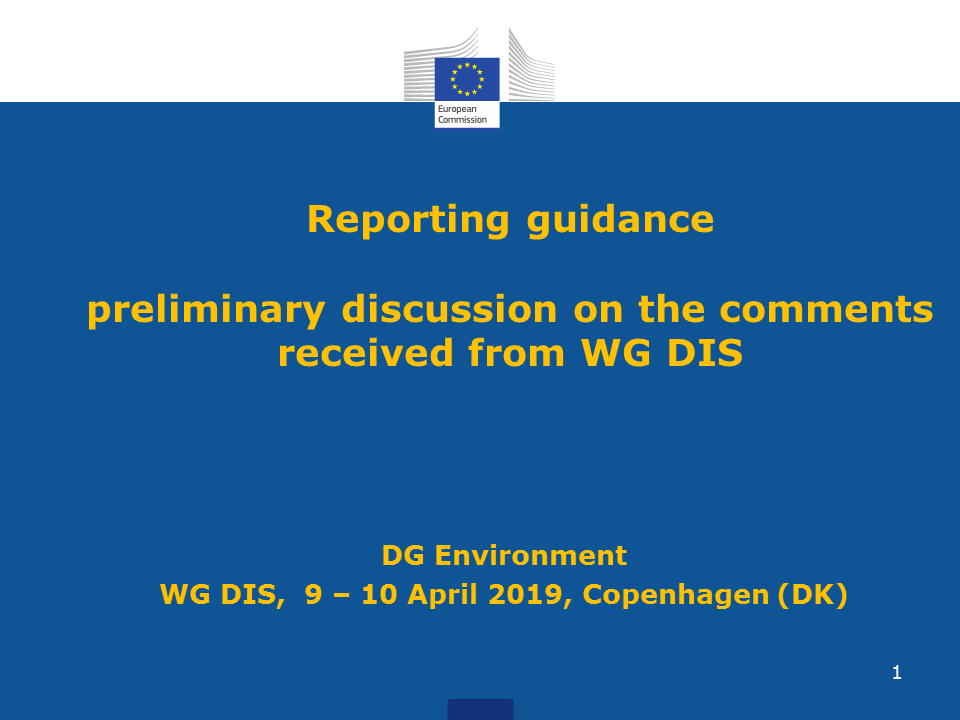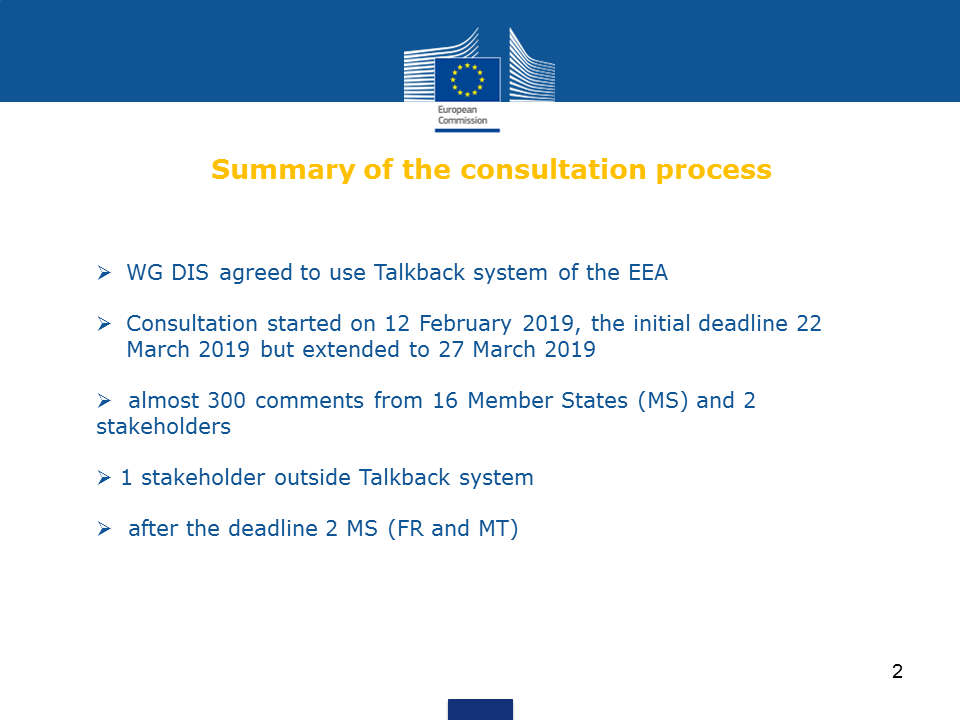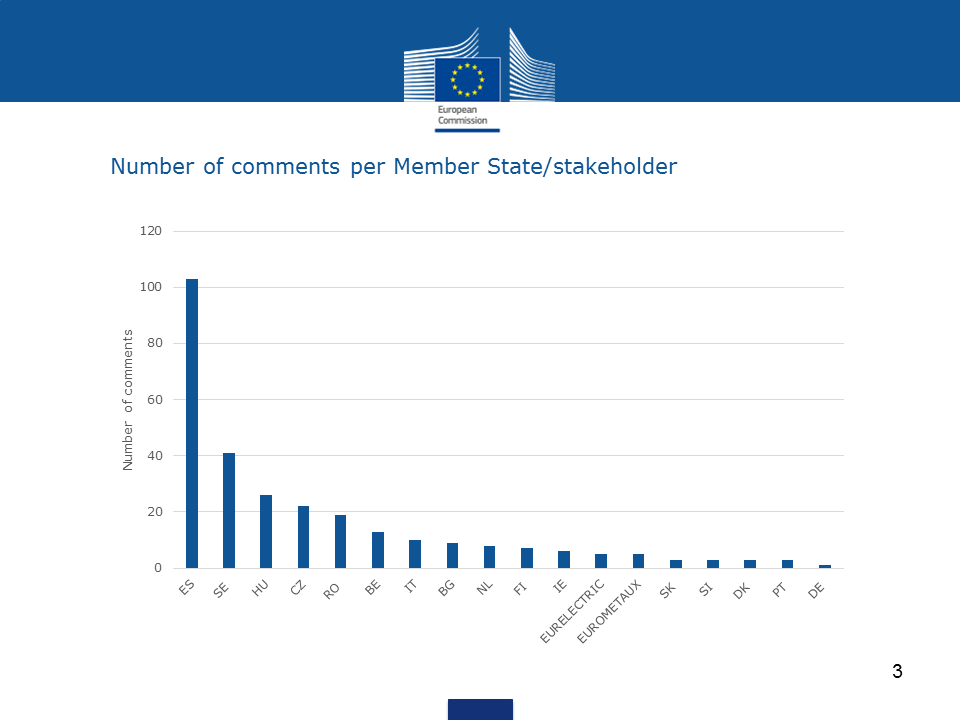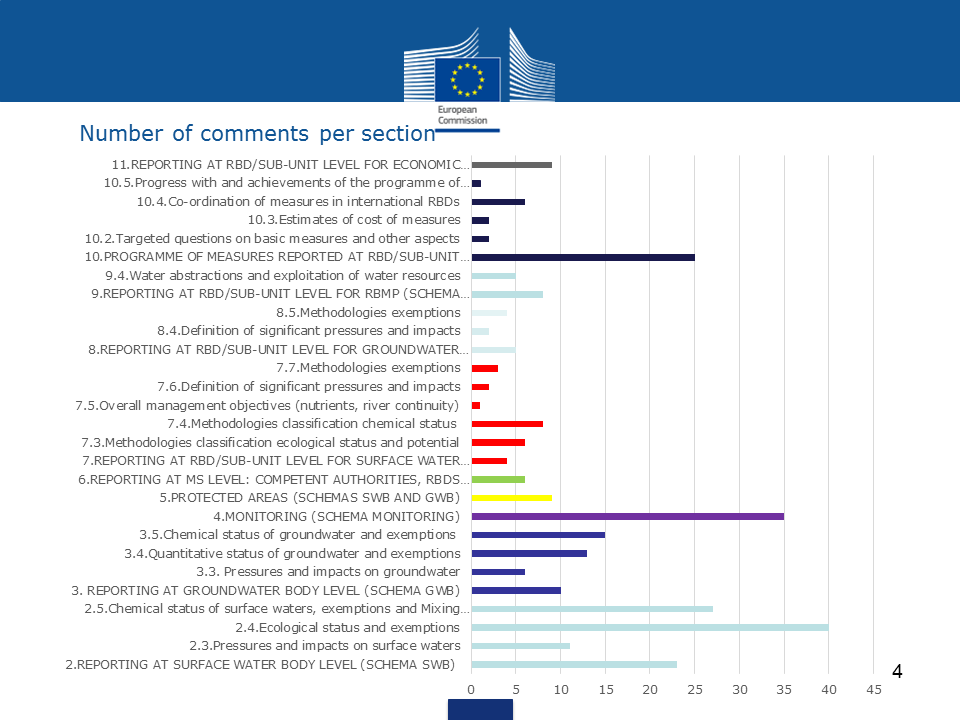Table of contents
- 2. REPORTING AT SURFACE WATER BODY LEVEL (SCHEMA SWB)
- 2.3. Pressures and impacts on surface waters
- 2.4. Ecological status and exemptions
- 2.5. Chemical status of surface waters, exemptions and Mixing Zones
- 3. REPORTING AT GROUNDWATER BODY LEVEL (SCHEMA GWB)
- 3.3. Pressures and impacts on groundwater
- 3.4. Quantitative status of groundwater and exemptions
- 3.5. Chemical status of groundwater and exemptions
- 4. MONITORING (SCHEMA MONITORING)
- 5. PROTECTED AREAS (SCHEMAS SWB AND GWB)
- 6. REPORTING AT MS LEVEL: COMPETENT AUTHORITIES, RBDS AND SUB-UNITS (SCHEMA RBDSUCA)
- 7. REPORTING AT RBD/SUB-UNIT LEVEL FOR SURFACE WATER (SCHEMA SWMET)
- 7.3. Methodologies classification ecological status and potential
- 7.4. Methodologies classification chemical status
- 7.5. Overall management objectives (nutrients, river continuity)
- 7.6. Definition of significant pressures and impacts
- 7.7. Methodologies exemptions
- 8. REPORTING AT RBD/SUB-UNIT LEVEL FOR GROUNDWATER (SCHEMA GWMET)
- 8.4. Definition of significant pressures and impacts
- 8.5. Methodologies exemptions
- 9. REPORTING AT RBD/SUB-UNIT LEVEL FOR RBMP (SCHEMA RBMPPOM)
- 9.4. Water abstractions and exploitation of water resources
- 10. PROGRAMME OF MEASURES REPORTED AT RBD/SUB-UNIT LEVEL (SCHEMA RBMPPOM)
- 10.2. Targeted questions on basic measures and other aspects
- 10.3. Estimates of cost of measures
- 10.4. Co-ordination of measures in international RBDs
- 10.5. Progress with and achievements of the programme of measures for the first planning cycle
- 11. REPORTING AT RBD/SUB-UNIT LEVEL FOR ECONOMIC ANALYSIS AND COST RECOVERY (SCHEMA RBMPPOM)
- Overview of comments presented at WG DIS
- WISE spatial data presentation at WG DIS
Overview of comments presented at WG DIS
Slide 1

Slide 2

Slide 3


General comments on the reporting guidance
- Names of features (e.g. surface water body, ground water bodies, monitoring sites) in national language
- Quality checks to be added
- To introduce also checks in the Access database
- Review enumeration lists/codelists to make them more “human readable” and/or update them where necessary
- Having error codes accompanied with an English explanation
- Harmonise the terminology in the guidance
- Adding “information not available”
- All GML data to be included in XML
- a document with all validation checks would be needed
- update the guidance including quality checks (documented in http://cdr.eionet.europa.eu/help/WFD/WFD_521_2016/QA-QC/QC%20Rules%206.0.6(XMLs).xlsx)
- In order to make the reading of the guidance easier, it would be appropriate to make hyperlinks to the corresponding Annex
2. REPORTING AT SURFACE WATER BODY LEVEL (SCHEMA SWB) including 2.3, 2,4 and 2.5
- hmwbWaterUse- Conditional. For HMWBs only, report the water use for which it has been designated- this is not the meaning of Art 4(3) of the WFD. (The designation of a WB as HMWB is related to the use that will be significantly affected if restoration measures were put in place.)
- Use of option “No” for transboundary water bodies with non – EU countries; at present the guidance states: “Transboundary water bodies are those crossing the border between countries or constituting part of the border between two countries for a certain length”
- Codelist of Annex 1a should not be split by drivers as usually the relation pressure-driver is 1 to n
2. REPORTING AT SURFACE WATER BODY LEVEL (SCHEMA SWB) including 2.3, 2,4 and 2.5 – cont.
- Adding quality element QE1-2-5 – Macrophytes and phytobenthos to the table StatusQE_Enum (or merging the 2 and leave only one element)
- Missing from MonitoringResults_Enum modelling and/or statistical analysis of pressure and impacts
- Update the chemical part of the guidance to take into account that reporting will be done according to Directive 2013/39/EU
- qeEcologicalExemptionsType(multi-pressure environment) - suggestion:
- - to become optional, or
- - to allow reporting similar to WISE of the 1st RBMP
- - to eliminate this table since this info was not relevant in the context of EC assessment
2. REPORTING AT SURFACE WATER BODY LEVEL (SCHEMA SWB) including 2.3, 2,4 and 2.5 – cont.
- Very few simplifications suggested i.e. excluding “No exemptions” in the ExemptionType_Enum
- Option to report separately chemical status for water matrix and for biota: a solution proposed is to introduce in the list “biota EQS”
- grouping of water bodies: 1) more guidance, 2) at WB level as it is now or QE or PS level
- Add in the MonitoringResults_Enum a combination monitoring/grouping
3. REPORTING AT GROUNDWATER BODY LEVEL (SCHEMA GWB) including 3.3, 3,4 and 3.5
- To be added reference to the identifier specifications included in the GIS guidance
- GWB layers not very useful - to discuss with WG Groundwater
- GW exemptions – when a WB has both 4(4) (time extension) and 4(5) (less stringent objective), the current GoodStatus_Enum does not help – suggestion to modify by removing from the codelist 'less stringent objective already achieved‘ and adding a new field in order to report the achievement of less stringent objectives for quality elements with a 4(5) exemption.
- Very few simplifications suggested e.g. delete the information on GWB at risk
4. MONITORING (SCHEMA MONITORING)
- Split the monitoring aspects into SW and GW (the table ”Chemical Monitoring” is very hard to manage due to its length)
- 'xxxLastMonitored' = 9999 if not yet monitored, but reporting is not about future monitoring
- Filling in the frequency and cycle for each site separately time consuming. Suggestion: to do this by program or per group of sites
- Very few simplifications suggested (e.g. class MonitoringPurpose redundant because it is also reported in the GML. hence to be deleted)
- Link to the EEA vocabulary list protected area
- Logic of SW ecological status for example i.e. swEcologicalStatusOrPotentialExpectedGoodIn2015 and swChemicalStatusExpectedGoodIn2015
- should be followed when talking about protectedXXXObjectivesMet
- Shellfish Directive vs Regulation on products of animal origin intended for human consumption (The monitoring and control of microbial contamination seems stricter according to the regulation than the old Shellfish directive.)
6. REPORTING AT MS LEVEL: COMPETENT AUTHORITIES, RBDS AND SUB-UNITS
(SCHEMA RBDSUCA)
- Information on Competent Authorities should be reported at RBD level not at Member State level
7. REPORTING AT RBD/SUB-UNIT LEVEL FOR SURFACE WATER (SCHEMA SWMET) including 7.3, 7.4, 7.6 and 7.7
- TypeSpecificReferenceConditionsforHyMoQEs, terminology is wrong, should be 'type-specific HyMo conditions' - further look into it before discussing
- Indicate whether a surface water body is a natural or a heavily modified or artificial water body (add a schema element)
- Delete Schema SWSupportingQE as the same information is provided Quality Element schema
- Suggestion for an option to indicate if the classification boundaries for a certain supporting QE and the class boundaries for sensitive BQE are reported in accordance with/are relevant to the water category
7. REPORTING AT RBD/SUB-UNIT LEVEL FOR SURFACE WATER (SCHEMA SWMET) including 7.3, 7.4, 7.6 and 7.7 (cont.)
- Look at the consistency with the CIS Guidance on implementing metals EQS
- The list of possible significant hydromorphological pressures should be revised to be more consistent with the WFD:
- −abstractions and water flow regulations (pressures that have impact on hymo element "hydrological regime“ e.g. water abstractions, impoundments etc),
- −interruptions of river continuity (pressures that have impact on hymo element "river continuity“ e.g. i.e weirs, dams, etc),
- −morphological alterations (pressures that have impact on hymo element "morphological conditions” (e.g. river engineering works, dredging etc).
9. REPORTING AT RBD/SUB-UNIT LEVEL FOR RBMP (SCHEMA RBMPPOM) including 9.4
- Inventory of emissions discharged into surface waters, suggestion is to establish the possibility to report e.g. total PAH and also single substances for emissions from major polluters.
- Inventory methodology should be reported only for those substances/pollutants that pass the relevance criteria, if "relevance RBD Scale" is "Yes". For others it should be optional. Conditional check: report if relevanceRBDScale is "Yes".
- weiNational – should be reported at national level. RBMPPoM module refers to RBD level information
9. REPORTING AT RBD/SUB-UNIT LEVEL FOR RBMP (SCHEMA RBMPPOM) including 9.4
- Clarification requested: if the term abstraction is always to be understood as “net consumption” as stated in chapter 9.4. If this is the case, it should be made clear in the description of pressure 3.5 – Abstraction or flow diversion – Hydropower Energy ‐ hydropower in Annex 1a that this is a reference to consumptive water use. If this is not the case, please make the necessary clarifications in chapter 9.4.
- (water abstractions) reportedUnderSoEQuantity – Required(YesNo) ought to show in WISE SoE data depository
10. PROGRAMME OF MEASURES REPORTED AT RBD/SUB-UNIT LEVEL (SCHEMA RBMPPOM) including 10.2, 10.3, 10.4 and 10.5
- The reporting is restrictive in being state rather than risk based. Suggestion: to accommodate the possibility to assign measures on the basis of risk which incorporates status
- Measures related to SW should not be separated from those related to GW as measures are common in many cases. e.g. diffuse sources of pollution from agriculture affect both SW and GW so the measures to reduce them will be the same.
- Gap and KTM Indicators
- There is no provision for the target to be set as high (only achievement of good status) therefore the provision to have environmental objectives as high needs to be provided for throughout the reporting database.
10. PROGRAMME OF MEASURES REPORTED AT RBD/SUB-UNIT LEVEL (SCHEMA RBMPPOM) including 10.2, 10.3, 10.4 and 10.5 (cont.)
- KTMs should be reviewed to incorporate MFSD KTM as measures for coastal waters are shared by both directives and those shared measures should not be classified in different KTM depending on the directive they relate to.
- KTM enumeration list should be spread to KTMs used by countries beyond RBMP2 enumeration list.
- Distinction to be made within “supplementary measures” as follows:
- KTMs should be reviewed to incorporate MFSD KTM as measures for coastal waters are shared by both directives and those shared measures should not be classified in different KTM depending on the directive they relate to.
- KTM enumeration list should be spread to KTMs used by countries beyond RBMP2 enumeration list.
- Distinction to be made within “supplementary measures” as follows:
- −Supplementary measures - achievement of objectives
- −Supplementary measures - additional protection
10. PROGRAMME OF MEASURES REPORTED AT RBD/SUB-UNIT LEVEL (SCHEMA RBMPPOM) including 10.2, 10.4 and 10.5 (cont.)
- Suggestion to delete “waterReUse” as the answer is too simplistic as water reuse is usually a better environmental option to desalinization for example but promoting it in catchments with high exploitation index will have important negative impacts in uses downstream
- Which option should be chosen by a ‘landlocked country’ if during the preparations of the RBMP and PoM the MS took into account the objectives of the Marine Strategy Framework Directive?


